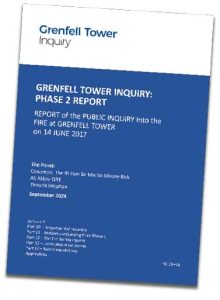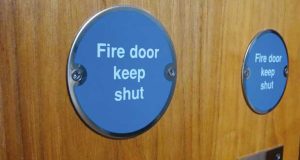 Peter Doyle, Head of Health and Safety at Citation discusses the key findings of the Grenfell Inquiry Phase 2 report and what it means for the future of building regulations and fire safety
Peter Doyle, Head of Health and Safety at Citation discusses the key findings of the Grenfell Inquiry Phase 2 report and what it means for the future of building regulations and fire safety
The publication last September of the final Grenfell report after a six-year public enquiry into the tragedy and the many failings that led to it has once again highlighted the importance of fire safety within the construction sector.
The 1,700-page report set out details of responsibility, as well as recommendations to the Government to help prevent future fire related tragedies. However, the critical point here is that the recommendations are just that – they’re not legislation and it’s up to the Government to decide whether to enact them.
Regardless of if legislation comes into place because of both inquiry reports, the impact they’ve had on fire safety within the construction sector is undisputed.
REGULATION & INSPECTION FAILURES
The fire highlighted serious deficiencies in fire safety regulations and enforcement. The Government had failed to update key regulations following previous fires, such as Approved Document B that provides guidance on how to meet building regulations, which meant that combustible materials were still authorised for use on higher-risk buildings.
Failings continued throughout the system as local authorities and private building inspectors did not effectively enforce fire safety standards, and inadequate fire risk assessments were conducted by individuals without appropriate training.
The inquiry recommended:
- Reformation of fire safety regulations, with clearer guidelines.
- Establishment of a national oversight body for building safety.
- Improvements to building inspection methods
- Improvements to competency surrounding fire risk assessments.
- Failures in accountability and communication.
The report found that both the Royal Borough of Kensington and Chelsea (RBKC) and the Central Government failed in their oversight and response to fire safety concerns. The RBKC did not intervene in the Tenant Management Organisation’s management of Grenfell Tower, despite repeated warnings. Central Government also failed to update fire safety regulations following previous incidents, such as the 2009 Lakanal House fire. This resulted in six deaths and at least 20 people injured when the tower block caught fire, which also involved combustible materials on the exterior of the building and breaches in safety regulations at the hands of the local council.
- Strengthened government oversight of housing safety.
- Improvements to communication with residents.
- Establishment of a national fire safety regulator.
- Establishment of a national body for building safety oversight.
- Mandatory installation of sprinkler systems in high-rise buildings.
- Improvements to accountability and resident involvement in fire safety.
MANAGEMENT AND OVERSIGHT FAILURES
The Tenant Management Organisation (TMO) responsible for Grenfell Tower was found to have repeatedly neglected fire safety responsibilities, including delayed responses to fire risk assessments and inadequate communication with residents. The TMO’s governance was flawed, lacking enough expertise in fire safety, and failed to act on critical fire safety concerns raised by residents and the London Fire Brigade.
The Inquiry recommended:
- Strengthened governance in housing management organisations.
- Improvements to resident engagement and accountability for fire safety.
WHAT’S HAPPENED SO FAR
The Grenfell fire has led to calls for significant reforms, not just in building regulations, but also housing management and emergency response. So far, the Building Safety Act, which came into effect following the tragedy, has introduced several requirements.
The Fire Safety (England) Regulations 2022 and section 156 of the Building Safety Act introduced additional duties for Responsible Persons under the Fire Safety Order, including building owners and landlords, or in the case of non-domestic workplaces, the employer is responsible.
The old ruling of “a fire risk assessment is only required for premises with five or more people” has been scrapped. The new legislation requires the Responsible Person to:
- Ensure that their fire risk assessor is competent to undertake an assessment of their premises based on their knowledge and experience.
- Record all fire risk assessment findings in full (regardless of their significance) – before, only significant findings were required to be recorded, which was open to interpretation.
- Record the identity of the individual and the company name of the person carrying out the fire risk assessment.
- Record their contact information, including a UK-based address. Where applicable, this information should be shared with other Responsible Persons and residents of multi-occupied residential premises.
- Record their fire safety arrangements to show how fire safety is managed on their premises.
NEXT STEPS
Following the final report, it is up to the Government whether the recommendations will become legislation and therefore enforceable by law.
However, it’s important to ensure that no matter what your involvement is with a higher-risk building, whether you’re a contractor, landlord or owner, that you update your processes to remain compliant with the latest building regulations and review the latest recommendations. It’s also crucial that if you are deemed a Responsible Person, you must ensure that your fire risk assessors have the competencies necessary for the job to guarantee the safest possible operations to protect businesses, livelihoods and lives.





